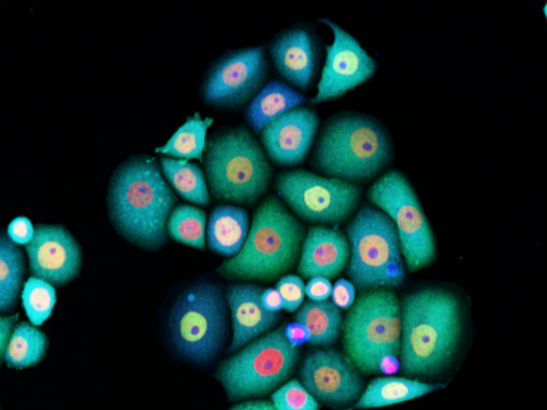
Image: Radiotherapy machine at The Royal Marsden Hospital (photo: Jan Chlebik/the ICR)
Women who received radiotherapy for early-stage breast cancer in fewer, larger doses experienced similarly low rates of late-onset side-effects as those receiving conventional treatment, results from a 10-year study show.
The findings, from the multi-centre FAST clinical trial, should help doctors discuss the potential risks and benefits of different courses of radiotherapy with their patients. The research also provides evidence to support a change in clinical practice so that women receive a shorter treatment overall.
The FAST trial was designed to assess changes in healthy breast tissue after a conventional radiotherapy regimen compared with two shorter treatments that involved delivering higher doses in fewer sessions.
The trial, led by The Institute of Cancer Research, London, enrolled 915 women with early-stage invasive breast cancer at 18 centres across the UK from 2004 to 2007.
Initial results from the FAST trial, which is funded by Cancer Research UK, indicated that once-weekly, shorter therapy led to similarly low normal tissue effects as conventional therapy at two years following treatment.
These new findings, presented today at the 60th Annual Meeting of the American Society for Radiation Oncology (ASTRO), show low side-effects are still recorded ten years after treatment.
You can help transform breast cancer research by supporting our programme of research into hormone receptor-positive breast cancer.
Whole-breast radiotherapy regimens
Researchers at The Institute of Cancer Research (ICR) randomly assigned patients to one of three whole-breast radiotherapy regimens following surgery. They received conventional treatment, which consisted of 50 Gray (Gy) of radation delivered every day for 25 days in fractions of 2Gy, or one of two shortened treatments.
The shortened treatments were either 30 Gy delivered once a week for five weeks in fractions of 6 Gy each or 28.5 Gy delivered once a week for five weeks in fractions of 5.7 Gy.
After treatment, patients were evaluated annually for effects to healthy breast tissue including skin reactions, hardening of the breast and changes in breast conformation and size.
Rates of moderate or severe long-term effects to normal tissue were low across all treatment groups. Severe effects were observed in 13 of the 774 women (1.7 per cent) with follow-up data at five years, and nine of the 392 women (2.3 per cent) with follow-up data at 10 years.
No changes or minor changes in normal tissue were observed in 88 and 86 percent of women at the five- and ten-year marks, respectively.
Shared decision-making between physicians and patients
Late normal tissue effects were not statistically different between the conventional therapy group and the five-fraction 28.5 Gy group at five years or 10 years following treatment.
Moderate/severe late effects to normal breast tissue were higher, however, for patients who received the five-fraction, 30-Gy regimen. These patients were two to three times more likely to experience moderate/severe instances of breast shrinkage, hardness, fluid build-up and spider veins.
Researchers also assessed how the early-stage invasive breast tumors responded to surgery and radiation.
The 10-year local relapse rate for all patients in the trial was 1.3 percent (95% CI 0.7, 2.3), with only 10 events reported in total, balanced between the treatment groups. The trial was not designed to test differences in relapse rates between treatment groups.
Professor Judith Bliss, Director of the ICR-CTSU, co-leads the FAST trial with Professor John Yarnold, Professor of Clinical Oncology at the ICR, who is the chief investigator of the trial.
Professor Murray Brunt, Professor of Clinical Oncology at University Hospitals of North Midlands and Keele University, who was lead author of this study, said:
“This study says it’s possible to find a regimen that would allow early-stage breast cancer patients to be treated only once a week over five weeks rather than daily over the same time period.
“The findings should help doctors discuss risks and benefits with their patients for various courses of radiation therapy and inform shared decision-making between physicians and patients.”
More convenient for patients
Joanne Haviland, Senior Statistician at The Institute of Cancer Research, London, and co-author of the study, said:
“These results support treatment options that are more convenient for patients, resulting in fewer hospital visits and less expensive health services, without increasing the risk of long-term side effects.”
The researchers now plan to investigate cutting radiotherapy treatment down to one week. Professor Brunt added:
“A schedule like this would have significant clinical and practical implications, such as allowing radiation therapy to be integrated more closely with surgery and other therapies.”
